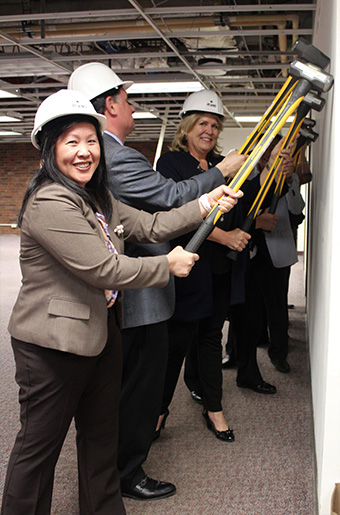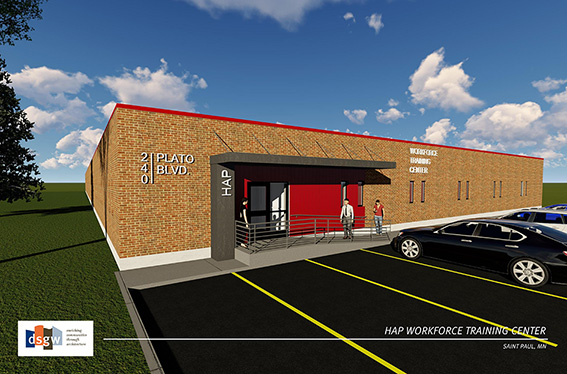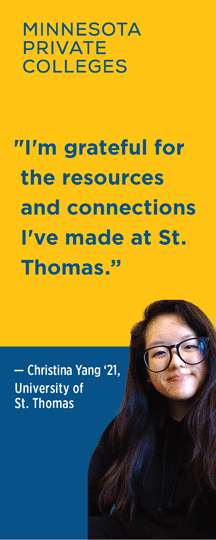The sledgehammers were meant to be symbolic - 10 hefty tools lined up against a wall in a vacant office building formerly occupied by a multinational corporation that makes oil and gas drilling equipment and components. The hammers were brought in by developer JB Vang as part of Hmong American Partnership’s April 25 “groundbreaking” ceremony for its new workforce training center scheduled to open this fall at 240 Plato Boulevard.
Guests of the groundbreaking weren’t actually supposed to slam their sledgehammers into the wall during the ceremony, but once the excitement took hold, it was too hard to hold back - the prospect of better job opportunities and higher wages was too exciting. The guests were eager to break down both the wall and barriers to employment that have long prevented many immigrant and refugee families from obtaining gainful employment.
Hmong households, in particular, have been disproportionately affected by unemployment and underemployment for decades. Poverty rates for Hmong families with children under the age of 18 hovered around 35 percent, according to data from the 2010 Census, and Hmong households had the lowest per capita income ($11,709) of any racial or any ethnic group in Minnesota, the State of the Hmong American Community 2013 report noted.
Meanwhile, many industries are facing shortfalls in skilled labor as baby boomers retire and younger individuals with training move out of state, a trend that has prompted experts to call for greater investment in workforce development among immigrants. “…Immigrants, both high skilled and low skilled, must be better incorporated into Minnesota’s economy more completely and rapidly, utilizing their existing human capital and increasing skills through training and education,” a 2017 University of Minnesota report noted.
HAP President and CEO Bao Vang couldn’t agree more. “When I sit at corporate tables and hear about the flat labor force… I say, ‘I have a solution.’ We are the solution to the state’s problem,” Vang said during the ceremony. “The fastest growing population in Minnesota is the Southeast Asians, with the Hmong as the largest demographic. Of this, over 50 percent of the Hmong are under the age of 24 years,” she added. “This is the future workforce of Minnesota.”
A Foundation For Future Success
A few swings of the sledgehammer later, and HAP had a jump-start on renovating the 29,000-square-foot building on Plato Boulevard. The building was gifted to the organization in 2016 and is one of two training centers to be renovated as part of a $14 million capital campaign. Funding for the campaign got a jump-start, too, when Governor Dayton signed a bonding bill in June 2018 that included $5.5 million in support of the two workforce centers.
Combined, the two centers will enable HAP to double the number of trainees it serves each year from 300 to 600. After completing training, participants are anticipated to earn an average salary of at least $37,000 per year, adding up to some $22 million in employment wages and $17 million in turnover cost savings to businesses.
The Plato site will house HAP’s Workforce Training programs in health care, manufacturing, information technology, hospitality, and business administration, with health care and IT to be the first courses provided. Pre-K and high school education will be offered at the site, as well, along with childcare for clients in day and evening classes.
HAP plans to relocate its Hmoob Toj Siab Montessori School to the new facility and increase enrollment from 30 to 60 students, a long-awaited expansion that will please several parents who want to enroll their children at the nation’s first Hmong/English Montessori school. And a 9th grade high school class is slated to start at the Plato site in September in partnership with HAP’s affiliate, the Community School of Excellence. Tenth through 12th grade classes will be added one grade level at a time over the following years. Students who decide not to attend college will have the opportunity to seek certification through one of the training programs at the campus.
This holistic approach to education and training has attracted support from several public officials, including Minnesota Department of Education Commissioner Mary Cathryn Ricker, who attended the groundbreaking. “This project that Hmong American Partnership has already started that is about to take its next step into fruition is one vibrant example of the spirit of Minnesota,” Commissioner Ricker noted at the event.
Members of the private sector are showing their support, as well. AT&T Minnesota President Paul Weirtz presented HAP with a $95,000 grant award for its Youth Job Skills program at the event. The grant is part of AT&T Aspire, the company’s signature philanthropic initiative focused on providing access to the education and training young people need to get and keep good jobs. AT&T Aspire has been a long-time supporter of HAP’s employment and training program, donating $475,000 in youth training grants over the past five years.
“They’re doing a great job of supporting young people and people of color to create these workforce opportunities for the future,” Weirtz told the Pioneer Press during an interview at the ceremony. “And that’s what we need for the state.”
Thanks to generous support from private businesses and city, county, and state officials, renovation on HAP’s Workforce Training Center on Plato Boulevard will soon swing into action, and those walls – and barriers to employment – will quickly come down.





















